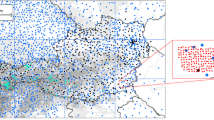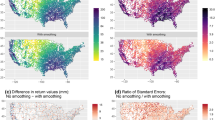Abstract
We study the influence of station network density on the distributions and trends in indices of area-average daily precipitation and temperature in the E-OBS high resolution gridded dataset of daily climate over Europe, which was produced with the primary purpose of Regional Climate Model evaluation. Area averages can only be determined with reasonable accuracy from a sufficiently large number of stations within a grid-box. However, the station network on which E-OBS is based comprises only 2,316 stations, spread unevenly across approximately 18,000 0.22° grid-boxes. Consequently, grid-box data in E-OBS are derived through interpolation of stations up to 500 km distant, with the distance of stations that contribute significantly to any grid-box value increasing in areas with lower station density. Since more dispersed stations have less shared variance, the resultant interpolated values are likely to be over-smoothed, and extreme daily values even more so. We perform an experiment over five E-OBS grid boxes for precipitation and temperature that have a sufficiently dense local station network to enable a reasonable estimate of the area-average. We then create a series of randomly selected station sub-networks ranging in size from four to all stations within the E-OBS interpolation search radii. For each sub-network realisation, we estimate the grid-box average applying the same interpolation methodology as used for E-OBS, and then evaluate the effect of network density on the distribution of daily values, as well as trends in extremes indices. The results show that when fewer stations have been used for the interpolation, both precipitation and temperature are over-smoothed, leading to a strong tendency for interpolated daily values to be reduced relative to the “true” area-average. The smoothing is greatest for higher percentiles, and therefore has a disproportionate effect on extremes and any derived extremes indices. For many regions of the E-OBS dataset, the station density is sufficiently low to expect this smoothing effect to be significant and this should be borne in mind by any users of the E-OBS dataset.










Similar content being viewed by others
Notes
ETCCDI meets under the auspices of the joint WMO Commission for Climatology, CLIVAR, Joint-WMO-IOC Technical Commission for Oceanography and Marine Meteorology.
References
Alexander LV, Zhang X, Peterson TC, Caesar J, Gleason B, Klein Tank AMG, Haylock M, Collins D, Trewin B, Rahimzadeh F, Tagipour A, Rupa Kumar K, Revadekar J, Griffiths G, Vincent L, Stephenson DB, Burn J, Aguilar E, Brunet M, Taylor M, New M, Zhai P, Rusticucci M, Vazquez-Aguirre JL (2006) Global observed changes in daily climate extremes of temperature and precipitation. J Geophys Res 111:D05109. doi:10.1029/2005JD006290
Barancourt C, Creutin JD (1992) A method for delineating and estimating rainfall fields. Water Resour Res 28:1133–1144
Beniston M, Stephenson DB, Christensen OB, Ferro CAT, Frei C, Goyette S, Halsnaes K, Holt T, Jylhä K, Koffi B, Palutikof JP, Schöll R, Semmler T, Woth K (2007) Future extreme events in European climate: an exploration of regional climate model projections. Clim Change 81:71–95. doi:10.1007/s10584-006-9226-z
Booij MJ (2002) Extreme daily precipitation in Western Europe with climate change at appropriate spatial scales. Int J Climatol 22:69–85. doi:10.1002/joc.715
Buonomo E, Jones RG, Huntingford C, Hannaford J (2007) On the robustness of changes in extreme precipitation over Europe from two high resolution climate change simulations. Q J Meteorol Soc 133:65–81. doi:10.1002/qj.13
Caesar J, Alexander L, Vose R (2006) Large-scale changes in observed daily maximum and minimum temperatures: creation and analysis of a new gridded dataset. J Geophys Res 111:D05101. doi:10.1029/2005JD006280
Chen C-T, Knutson T (2008) On the verification and comparison of extreme rainfall indices from climate models. J Clim 21:1605–1621. doi:10.1175/2007JCLI1494.1
Christidis N, Stott PA, Brown S, Hegerl GC, Caesar J (2005) Detection of changes in temperature extremes during the second half of the 20th century. Geophys Res Lett 32:L20716. doi:1031029/2005GL023885
Feng S, Hu Q, Qian W (2004) Quality control of daily meteorological data in China, 1951–2001: a new dataset. Int J Climatol 24:853–870. doi:10.1002/joc.1047
Fowler HJ, Ekström M, Kilsby CG, Jones PD (2005) New estimates of future changes in extreme rainfall across the UK using regional climate model integrations. 1. Assessment of control climate. J Hydrol 300:212–233. doi:10.1016/j.jhydrol.2004.06.017
Gerstner E-M, Heinemann G (2008) Real-time areal precipitation determination from radar by means of statistical objective analysis. J Hydrol 352:296–308. doi:10.1016/j.jhydrol.2008.01.016
Groisman PY, Knight RW, Easterling DR, Karl TR, Hegerl GC, Razuvaev VN (2005) Trends in intense precipitation in the climate record. J Clim 18:1326–1350
Hanson CE, Palutikof JP, Livermore MTJ, Barring L, Bindi M, Corte-Real J, Durao R, Giannakopoulos C, Good P, Holt T, Kundzewicz Z, Leckebusch GC, Moriondo M, Radziejewski M, Santos J, Schlyter P, Schwarb MC, Stjernquist I, Ulbrich U (2007) Modelling the impact of climate extremes: an overview of the MICE project. Clim Change 81:163–177
Haylock MR, Hofstra N, Klein Tank AMG, Klok EJ, Jones PD, New M (2008) A European daily high-resolution gridded data set of surface temperature and precipitation for 1950–2006. J Geophys Res 113, D20119. doi:10.1029/2008JD010201
Hewitson BC, Crane RG (2005) Gridded area-averaged daily precipitation via conditional interpolation. J Clim 18(1):41–57
Hewitt CD, Griggs DJ (2004) Ensembles-based predictions of climate changes and their impacts. EOS 85:566–568
Hofstra N, New M (2009) Spatial variability in correlation decay distance and influence on angular-distance weighting interpolation of daily precipitation over Europe. Int J Clim 29:1872–1880. doi:10.1002/joc.1819
Hofstra N, Haylock M, New M, Jones PD, Frei C (2008) The comparison of six methods for the interpolation of daily, European climate data. J Geophys Res 113:D21110. doi:10.1029/2008JD010100
Hofstra N, Haylock M, New M, Jones PD (2009) Testing E-OBS European high-resolution gridded dataset of daily precipitation and surface temperature. J Geophys Res (in press). doi:10.1029/2009JD011799
Huntingford C, Jones RG, Prudhomme C, Lamb R, Gash JHC, Jones DA (2003) Regional climate-model predictions of extreme rainfall for a changing climate. Q J Meteorol Soc 129:1607–1621. doi:10.1256/qj.02.97
Jones PD, Reid PA (2001) Assessing future changes in extreme precipitation over Britain using regional climate model integrations. Int J Climatol 21:1337–1356. doi:10.1002/joc.667
Kjellström E, Ruosteenoja K (2007) Present-day and future precipitation in the Baltic Sea region as simulated in a suite of regional climate models. Clim Change 81:281–291. doi:10.1007/s10584-006-9219-y
Klein Tank AMG, Können GP (2003) Trends in indices of daily temperature and precipitation extremes in Europe, 1946–99. J Clim 16:3665–3680
Klok EJ, Klein Tank AMG (2009) Updated and extended European dataset of daily climate observations. Int J Climatol 29:1182–1191. doi:10.1002/joc.1779
McSweeney CF (2007) Daily rainfall variability at point and areal scales: evaluating simulations of present and future climate. University of East Anglia, Norwich, p 256
New M, Todd M, Hulme M, Jones PD (2001) Precipitation measurements and trends in the twentieth century. Int J Climatol 21:1899–1922. doi:10.1002/joc.680
Osborn TJ, Hulme M (1997) Development of a relationship between station and grid-box rainday frequencies for climate model evaluation. J Clim 10:1885–1908
Piper SC, Stewart EF (1996) A gridded global data set of daily temperature and precipitation for terrestrial biospheric modeling. Global Biogeochem Cycles 10(4):757–782
Reynolds RW (1988) A real-time global sea surface temperature analysis. J Clim 1:75–86
Rubel F, Brugger K, Skomorowski P, Kottek M (2004) Daily and 3-hourly quantitative precipitation estimates for ELDAS, edited. Biometeorology Group, University of Veterinary Medicine, Vienna, 32 p
Santos JA, Corte-Real J, Ulbrich U, Palutikof JP (2007) European winter precipitation extremes and large-scale circulation: a coupled model and its scenarios. Theor Appl Climatol 87:85–102. doi:10.1007/s00704-005-0224-2
Semmler T, Jacob D (2004) Modeling extreme precipitation events—a climate change simulation for Europe. Glob Planet Change 44:119–127. doi:10.1016/j.gloplacha.2004.06.008
Simmons AJ, Jones PD, da CostaBechtold V, Beljaars ACM, Kållberg PW, Saarinen S, Uppala SM, Viterbo P, Wedi N (2004) Comparison of trends and low-frequency variability in CRU, ERA-40, and NCEP/NCAR analyses of surface air temperature. J Geophys Res 109:D24115. doi:10.1029/2004JD005306
Thom HCS (1958) A note on the gamma distribution. Mon Weather Rev 86:117–122
Van der Groot E, Orlandi S (2003) Technical description of interpolation and processing of meteorological data in CGMS, pp 16
Wilks DS (2006) Statistical methods in the atmospheric sciences, 2nd edn. Elsevier, Burlington, p 627
Acknowledgments
We would like to thank all institutes (see Appendix 1 of Klok and Klein Tank (2009)) that made meteorological station data available for the study. This study was funded by the EU project ENSEMBLES (WP 5.1 contract GOCE-CT-2004-50539). NH is also funded by the Dutch Prins Bernhard Cultuurfondsbeurs and the Dutch talentenbeurs.
Author information
Authors and Affiliations
Corresponding author
Rights and permissions
About this article
Cite this article
Hofstra, N., New, M. & McSweeney, C. The influence of interpolation and station network density on the distributions and trends of climate variables in gridded daily data. Clim Dyn 35, 841–858 (2010). https://doi.org/10.1007/s00382-009-0698-1
Received:
Accepted:
Published:
Issue Date:
DOI: https://doi.org/10.1007/s00382-009-0698-1




